欧洲文化入门 ( 三 )
- 格式:ppt
- 大小:2.87 MB
- 文档页数:51
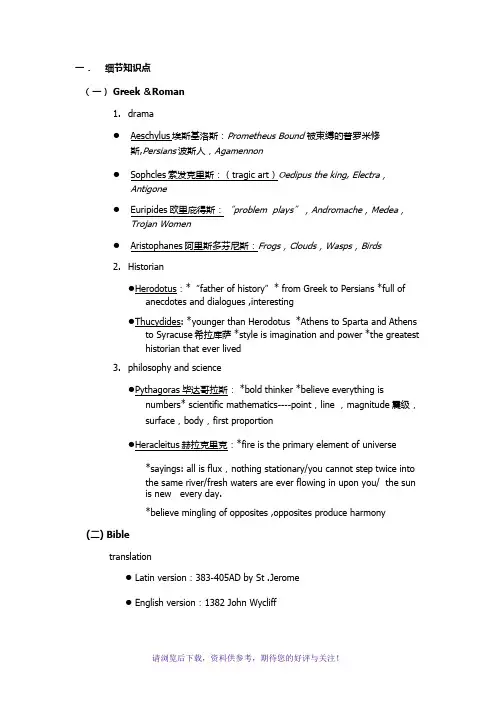
一.细节知识点(一)Greek &Roman1.drama●Aeschylus埃斯基洛斯:Prometheus Bound被束缚的普罗米修斯,Persians波斯人,Agamennon●Sophcles索发克里斯:(tragic art)Oedipus the king, Electra,Antigone●Euripides欧里庇得斯:“problem plays”,Andromache,Medea,Trojan Women●Aristophanes阿里斯多芬尼斯:Frogs,Clouds,Wasps,Birds2.Historian●H erodotus:*“father of history”* from Greek to Persians *full ofanecdotes and dialogues ,interesting●T hucydides: *younger than Herodotus *Athens to Sparta and Athensto Syracuse希拉库萨 *style is imagination and power *the greatesthistorian that ever lived3.philosophy and science●P ythagoras毕达哥拉斯: *bold thinker *believe everything isnumbers* scientific mathematics----point,line ,magnitude震级,surface,body,first proportion●H eracleitus赫拉克里克:*fire is the primary element of universe*sayings: all is flux,nothing stationary/you cannot step twice intothe same river/fresh waters are ever flowing in upon you/ the sunis new every day.*believe mingling of opposites ,opposites produce harmony(二) Bibletranslation●Latin version:383-405AD by St .Jerome●English version:1382 John Wycliff(三)Middle ages/ Medieval1. AD 476 Roman power was gone2. after 1054 Church was divided into Roman Catholic and Eastern OrthodoxChurch3.The Crusades: 1096-1291 last for about 200 years4.learning:● Charlemagne查理曼大帝:*western and central Europe*father of Europe .Emperor of Romans in 800*Carolingian Renaissance加洛林*encourage Christian religion and ancient learning by setting monasteryschools● Alfred the Great阿尔弗雷德大帝:*ruler of Anglo Saxon of Wessex*Encourage teacher and scholars , Wessex center of learning*Anglo Saxon chronicles英国编年史● St .Thomas Aquinas*Italian philosopher ,scholasticism经院哲学*Summa Contra Centiles , Summa Theologiae 《神学大全》*building a society of “God’s rule””God’s will”,Pope is“Christ’splenipotentiary基督的全权代表” above secular rulers● Roger Bacon罗杰培根*a British monk ,one of the earliest advocates of experimental scientificresearch and observation*works :Opus maius ,encyclopedia of the sciences of his time5.Literature●Beowulf :an Anglo Saxon epic● Song of Roland ,La Chanson de Gestes: French● Dante:the divine of comedy神曲 greatest poet of Italy●Geoffrey Chaucer 乔叟:English poet :canterbury tales坎特伯雷故事集,(first short story teller, first modern poet in English literature )(四)Renaissance1.started in Florence and Venice, Italy2.heart of Renaissance philosophy is greatness of man ,humanism3.masterpieces :● Giovanni Boccaccio薄伽丘:Decameron十日谈(the greatest achievementof prose fiction 散文小说in the middle ages)● Francesco Petrarch彼德拉克:*discover Cicero’s Oration Oro Arochia,a Roman defense of poetry*Works: Canzoniers(lyrical), Africa,Metrical Epistles,On Contempt forthe Worldly Life,On Solitude,Ecologues, The Letters●Giotto乔托:*forerunner of Renaissance,led the way to humanism,realistic depiction of space*works: Flight into Egypt ,Betrayal of Juda s●Giorgione乔尔乔捏:Tempesta , Sleeping Venus(use of colour schemes to unify picture and most revolutionaryresult in this sphere)●Leonardo da Vinci:*painter, sculptor, architect, musician, mathematician, engineer, inventor,anatomist, geologist, cartographer, botanist, and writer.*12 paintings 5000 books ,Renaissance man in the true sense of word.*Last Supper(most famous religious pictures), Mona Lisa(most portrait)●Michelangelo Buonarroti:* an Italian sculptor, painter, architect, poet, and engineer* David ,Sistine Chapel ,Dying Slave ,Moses●Raphael:Madonna(Virgin Mary)各种圣母画,school of Athens● Rabelais拉伯雷: French ,Gargantua and Pantagruel《巨人传》● Pleiade 七星诗社:French ,leader is Pirre de Ronsard(Sonnet PourHelene) ,发扬保卫法兰西语言●Cervantes塞万提斯:Spanish,Don Quixote 1062● Erasmus:Dutch, Renaissance humanist, Catholic priest, teacher, andtheologian,Greek edition of New Testament ,Praise of Folly《愚人颂》●Durer : German ,follower of Martin Lutherthe four horsemen of apocalypse 天启四骑士knight ,death and the devil●Thomas more:英国人,Utopia乌托邦,conclusion●Shakespeare:英国人Twelfth night ,As you like it ,Hamlet,Othello,King Lear ,Macbeth,Antony and Cleopatra,Sonnets, King Henry 5,6二 .名词解释1.RenaissanceRenaissance is a period of western civilization between 14-17th century.The word Renaissance means revival .it also means the revival of interestin ancient Greek and Roman culture,which started in Florence andVenice ,Italy . the heart of~is humanism.2 . Reformation~ was a 16th century religious movement as well as a socio-political movement ,which began with Martin Luther’s 95 theses in 1517. TheReformation began as an attempt to reform the Roman Catholic Church.3.Middle ages :~is also called Medieval ,”the year of faith”* or the thousand-year period following the fall of the western roman empire in the 5th century .it camebetween ancient times and modern times .During this period Germanickingdom grew into nations such as England ,French ,Spain, Italy, Germany.4 . Feudalism~is a system of holding land in exchange for military service .the word~was derived from the Latin “feudum” , a grant of land.5 Catholic~Means” universal”. ~church was a highly centralized and disciplinedinternational religious organization .in the middle ages ,almost everyEuropeans belonged to it.6. old testament~is one of the two parts of the Bible ,which is about the God and the laws of God. Testament means agreement—the agreement between God and man.7. Pentateuch 摩西五书The oldest first five parts of the Bible including Genesis ,Exodus,Leviticus, Numbers, Deuteronomy8. doric :one of Greek architecture styles,~is also called masculine style .it’s sturdy 坚定的,powerful,severelooking ,showing sense of proportions andnumbers.Ionic:feminine style graceful and elegant,showing wealth of ornament装饰三.问答1. What happened in Western Europe after the decline of the Roman Empire?After the Roman Empire lost its predominance优势, a great many Germanic Kingdoms began to grow into the nations know as England, France, Italy, andGermany in its place. These nations of Western Europe were in the scene of frequent wars and invasions. The political unity had given way to widespread destruction and confusion. Hunger and disease killed many lives and village fell into ruin and great areas of land lay waste. There was no central government to keep the order. The only organization that seemed to unite Europe was the Christian church. Christianity was almost the all and the one of Medieval lives in western Europe and took lead in politics, law, art, and learning for hundreds years.2. What were the cultural characteristics of the period from 500 to 1000? Above all, the cultural characters of this period were the heritage and achievement of Roman culture and the emergence of Hebrew and Gothic culture.3.What made Italy the birthplace of the Renaissance?Because of its geographical position, foreign trade developed early in Italy. This brought Italy into contact with other cultures and gave rise to urban economy and helped Italy accumulate wealth which was an essential factor for the flowering of art and literature.For two centuries beginning from the late 15th century, Florence was the golden city which gave birth to a whole generation of poets, scholars, artists and sculptors. There was in Florence a revival of interest in classical learning and rising of humanist ideas.And to spread the new ideas, libraries and academies were founded.In the 15th century printing was invented and helped to spread humanist ideas.4. How did Italian Renaissance art and architecture break away from medi eval traditions?The Italian Renaissance art and architecture radically broke away from the medieval methods of representing the visible world. Compared with the latter, the former has t he following distinct features:⑴Art broke away from the domination of church and artist who used to be craftsmen commissioned by the church became a separate strata doing noble and creati ve work⑵Themes of painting and architecture changed from purely celestial realm focusingon the stories of the Bible, of God and Mary to an appreciation of all aspects of n ature and man;⑶The artists studied the ruins of Roman and Greek temples and put many of the principles of ancient civilization into their works;⑷Artists introduced in their works scientific theories of anatomy and perspective.。
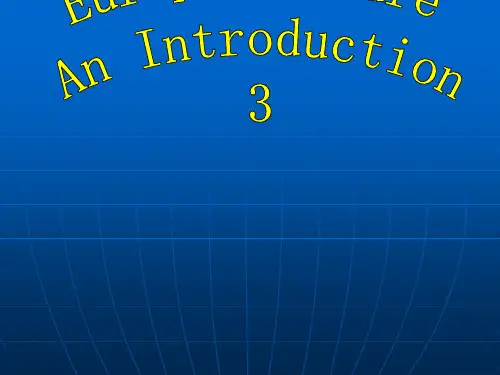
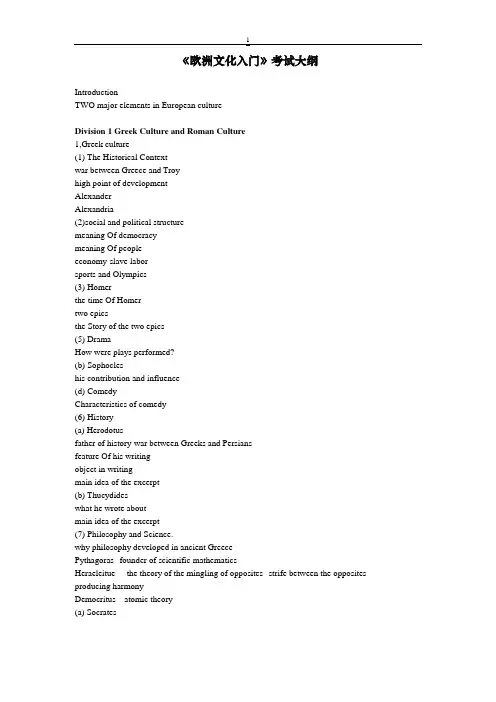
《欧洲文化入门》考试大纲IntroductionTWO major elements in European cultureDivision 1 Greek Culture and Roman Culture1,Greek culture(1) The Historical Contextwar between Greece and Troyhigh point of developmentAlexanderAlexandria(2)social and political structuremeaning Of democracymeaning Of peopleeconomy-slave laborsports and Olympics(3) Homerthe time Of Homertwo epicsthe Story of the two epics(5) DramaHow were plays performed?(b) Sophocleshis contribution and influence(d) ComedyCharacteristics of comedy(6) History(a) Herodotusfather of history-war between Greeks and Persiansfeature Of his writingobject in writingmain idea of the excerpt(b) Thucydideswhat he wrote aboutmain idea of the excerpt(7) Philosophy and Science.why philosophy developed in ancient GreecePythagoras--founder of scientific mathematicsHeraeleitue----the theory of the mingling of opposites--strife between the opposites producing harmonyDemocritus---atomic theory(a) Socrates -his method of argumenttrial and the reasonlast part of the speech before he died(main idea) (b) Platohis Lifehis writinghis philosophy---idealism© Aristotlehis liferange of his writingshis influencedifference between Plato and Aristotle(d) Contending Schools of Thoughtthe Cynicsthe Epicureans--their belief misrepresent8tion the Stoics--their theory(e) Sciencecontribution of philosophers like PlatoEuclid---ElementsArchimedes---his contributionapplication of science; five fields(8) Art, Architecture, Sculpture and Pottery(b) Archit6CtueParthenonthree stylesAcropolis at Athens(9) impact(a) spirit of innovation(b) supreme achievement© Greek philosophy and its influence influence of Greek Literature2, Roman Culture(1 ) Romans and GreeksLatin and Greeksimilarity Of Romans and Greeksone big diff6renceattitude forward Greek Culture(2) Roman Historyimportance of the year 27B.Chow to ruleRoman lawEast and West Roman Empires(3) Latin literatureCicero what was he noted for?his role and contributionhis sayingsCaesar: his rolehis sayings(b) PoetryVirgil; A6neas;the storywhy a tragic hero(4) Architecture, Painting and Sculpture(a) Architecturethe Pantheonthe Colosseum© sculpture tShe-wolfDivision 2 The Bible and Christianity1, General introductionrole of Christianity in western Culture importance of Judeo-Christian tradition the Hebrews 2. The Old Testament.two parts of the Biblemeaning of testament(1 ) the Pentateuchthe first five booksthe creation Of the world and man and woman (a) the fall of manthe main idea Of the Story(b) Noah's Arkthe Story(2) The Historical Booksthe history covered in these works(4) © The book of Danielthe story and the visionTorahJews today3,Rise of Christianitytwo beliefs of Christianity(1)The Life of JesusJesusSt. petier and St. Pauluprising of Spartacus(2) The Spread of Christianitysuppression of the religionreligion of people from all classesEdict of Milana weapon in the hands of the ruling class4, The New Testamentorganization of the churchfour accounts about church(1 ) The birth of Jesus-(2) the Last Supperthe main idea of the story(5) The cruxifixionthe main idea of the story5. Translations of the Biblethe Latin Biblethe number of transl8tion todaythe first English versionAuthorized versionrevised versionDivision 3 The Middle Ages1, General Introductionthe term "Middle Ages"(time span)Europe between the 5th and the 11th centuriesthe reason for the name “the Age Of Faith"classical, Hebrew and Gothic heritages merged2, Manor and Church(1) feudalism in Europe(a) Growth of Feudalismthe reason for the growth of the power of big landowners fief(b) The Manormanor? manor house? castle© Knighthood and code Of Chivalryhow to earn a knighthoodcode of chivalry(2) The churchafter 1054,two divisions of the church(a) nature of the Catholic Church (P.92 L10 from bottom) the chart(b) Power, Wisdom and Lovemonasteries and conventscontribution of St JeromeAugustine and his worksSt. Benedict© classeschurch and kings and noblesthe power Of the popereligion in everyday life(end of P.95 and first 7 lines of P.96) (3) The crusadesreason for the crusadeseffect on the East and the West'''3, Learning and, Science(1) Charlemagne: his lifehis contribution(2) Alfred the Great(3) Aquinas: profession, writings and arguments4, Lit6rature(1 ) meaning of "national epic'its importance(a) Beowulf (the story)(2) Dante and his master piece(3) Chaucer and his literary roleThe Canterbury Tales5, Art and Architecture(2) Gothicthe development Of the Gothic Stylethe expression of the styleDivision 4 Renaissance and Reformation1,GeneraI Introductiontime span /definition/ contribution /development2, Renaissance in Italy(1 ) geographical Location and its benefitcity----Statespread of Renaissance(2) new interestrole of intellectualscore of Renaissance philosophythe reIat6d beliefearly humanists(4) Renaissance Art4. distinct features(b) (i) da V incithe man /range of interest /famous works(ii) Michelangelothe man /Style /works(iii) RaphaelMadonna and School Of Athens(iv) Titianhis role and works(5) Decline of the Italian Renaissancereasons for the decline3. Reformation and Count6r ------Reformationbeginning of reformationgoal of the movementdemand and work of the reformistsint6reSts Of the reformists(1 ) Pre---Luther Religious Reformers(a) Wycliffe life and belief(b) Jan Hus preaching in Czech language and result(2) Martin Luther and his doctrine(a) beginning Of the reform(b) reason for the transition of the Bible© his role(3) John Calvin and Calvinismlife/view / definition of Calvinism(P.147-- paragraph1)(4) Reformation in Englandbreak with the Popethe coming into being Of the Church Of Englandessence Of the reform,(5) Counter ---reformationmeaning of count6r---reformationthe seed --bedthe most important thing the Spanish monarchy did(b) Ignatius and the things he didthe Jesuits, their belief, their influence(6) Prot6Stantism and the Rise of Capitalismmeaning Of Protestantism and its developmentthe factors contributing to the rise of capitalism(7) Conclusionpolitical and economic situation in Europe before Reformation the language used before Reformation4,Renaissance in Other Countries(1 ) in France(b) (i) Rabelaisthe man / his writing/Chapter57;man idea(iii) Monteignethe man /his writings(2) in Spain(b) Cervanteshis life/ famous work /the story of the work(4) in England(a) characteristics of the reign of Elizabeth l© Shakespearelif6 and worksthe story of HamletSoliloquy5, Science and T6chnology(1 ) Geographical DiscoveriesColumbus 4DiasGamaAmerigo(2) AstronomyCopernicus(5) Political Science and Historiography(b) Machiavellihis role and worksthe two selected passages6, Summing---upsignificance of this periodDivision 5 17th Century1, General introductionthe significance Of the 17th centuryman's place in the universepolitical struggle2. Science(1 ) the theory put forward by CopernicusIif6 of Copernicusthe three laws Kepler(2) life Of Galilei /acceleration in dynamics/law of falling bodies(3) Newton’s life/law of gravitation /his influence(4) Leibnizhis life /his belief /New Essays Concerning Human Understanding----three levels of understanding /Contribution (b) the two merits3, Philosophy, Politics and Literature in England(1) Baconhis life and worksbasis of his philosophy ---method ---inductionview on knowledgeweaning of inductionfamous quotations(2) Hobbesknowledge coming from experiencenature of man --in a Stat6 of war with one anotherlaws Of naturesocial contract(3) John Lockehis Lifeknowledge from experiencepolitical philosophy-rejection of divine right of kings and natural rights social contract(4) Milton and the English Revolutioncauses Of the English Revolutiondevelopment of capit8Iism in Englandthe Puritan MovementCivil War of 1642---CromwellGlorious Revolution of 1688Bill of Rights of 1689John Melton’s life and works Paradise Lost(the story)4.Descartes.French Classicismgeneral situation: the need for a powerful king(1)Descartes; his role(a) 4 roles Of his method(b) doubting---thinking© dualism(2) French Classicism4finition of classicismFrench classicism of the 17th century(3) characteristic of neoclassicism© Molierehis rolecontent of his comediesTartuffe5,Art(1 ) Baroque Art(参照P221 Music)(b) Michelangelo :his role and works (要与p.135 区分)(2) Dutch Protestant Artreason for art developmentRembrandt: his role and worksDivision 6 The Age of Enlightenment1, General Introduction(1 ) Enlightenmentdefinitionintellectual originmajor forcefour ramifications(2) Historical backgroundAmerican RevolutionFrench Revolutionindustrial Revolution: developments2,French Philosophy and Literature(1 ) Mont6squies(a) content of Persian Letters(b) The spirit of the Lawswhat it is aboutredefinition of lawview on government (separation of powers)(2) V oltaire(a) content of the letters(b) content of Candidethe quotations(3) Rousseau(a) main idea of The Origin Of Human Inequality(b) the kind of socie ty proposed in “The Social contract"his view on social contract(e) three famous quot8tions from "The Conf6ssions"(4) Diderotthe thing he was famous for(a) philosophical thought© Encyclopedie(d) Elements of Philosophy(e) R~~Nephew: the first paragraph3, English Literature(2) Defoe’s role and worksstory of “Robinson Crusoe"(3) Jonathan Swifts role and workscont6nt Of 'A modest Proposal"story Of “Gulliver’s Travels(5) reason why Fielding was considered “father of English Novel” 4,German Literature and Philosophy(2) Goetherole of Goethe(a) importance of "The Sorrows of Y oung Wu rther”(d) importance of "Faust"(3) Schiller'his role(b) main idea of "Cabal and Love"(d) “Whlhelm Tell” and what is stresses(4) Kanthis contribution(b) main idea of "Critique of Pure Reason"6, Music(1 ) the achievement of musical Enlightenment(a) Bach: Life and role(b) Handel: life and works(2) The Classical Periodimportance of this periodthe Viennese School(a) Haydn: his contribution(d) Mozart: life, achievement and contributionsynopsis of "The Marriage of Figaro',Division 7 Romanticism1, General introduction(参照P.309) ?(1) What is Romanticism?Things in common in the works of Romantic writ6rs expression in philosophyexpression in music(2) The French and Industrial Revolution(参照P.225---P.226) 3, Romanticism in England(1) BlakeWhat did "song of Innocence” and "Song of Experience "show? What were the tones Of these two collections?What do the Lines in “London” show?(2) LakersWhat was the new lit6rary theory?Who were the two young poets?What do you know about them?(3) ByronWhat did he fight for and die for?Why was he liked in China?his works and influence(4) Shelleythe memorable line Of "Ode tO the W6st Wind"the story of Prometheus Unbound(5) Keatshuman misery in "Ode to a Nightingaleending of "Ode on a Grecian Urn”4. Romanticism in France(2) Hugothe cause of a riot between the classicists and the Romanticists the thing Hugo was noted forthe plot of Les Miserable6, Romanticism in Russiainfluence Of Romanticism on Russia(1 ) Pushkinmain idea of "Ruslan and Liudmila"the story and the lesson of “Boris Godunov”the story of “Eugene Onegin”What do the two characters in "Eugene Onegin" stand for?(2) Lermontovthe Story of 'A Hero of our Time"feature Of Lermontov’s writings8. Concluding Remarksappraisal of the Romantic Movementtwo factors mentioned by an English writer10, MusicWhat exercised a more direct influence on music?What was the f6ature of Romantic music?(1 ) The Early Romantics?(a) Beethovenlife and works, spirit and techniquerole and contributionthe program that can be seen in his works6th and 9th Symphonies and their f6atures(b) Schubert: his life and role© Chopin: life and role(d) Schumann: life and role(e) MendelssohnWhat was so outstanding Of him?(2) The later RomanticsWho should be put in this group?Who were the "three B's"?(b) Tchaikovsky: lif6 and roleDivision 8 Marxism and Darwinism1. The Rise of Marxism(1 ) General Introductionthe int6IIeCtual tradition it was associated with the effect it has on various fields(参照p.535 summing-up)(2) Historical Background(3) The Three Sources(a) German Classical Philosophy(i) HegelWhat did Hegel maintain(ii) Why was Feuerback important?(iii) What did Marx and Engel’s adopt and reject in term of Hegel’s and Feuerbach's philosophies? What is the main idea of the selected passage from the end of P.330 to the beginning of P.332? Lenin's comments (P.336---P.337)(iv) four conclusions Of Marx’s historical materialism(b) English Classical Political EconomyWhat is the cornerstone of Marx’s economic theory?How did L6nin summarize Marx’s economic theory?What are the differences between Marx’s economic theory and bourgeois economics theories?(C)Utopian SocialismWhy was it called "Utopian"?(l) Owen(ii) Saint--Simon(iii) Charles FourierWh8t was the problem with them?What is the essence of Marxist socialism?2. Darwinism(1 )General introductionWhat did Darwin discover?What idea did he challenge?his role(3) life of Charles Darwin(4) Darwin’s Works and Theories(a) Origin Of SpeciesWhat is the essence Of his theory Of evolution?What are the four major arguments?What are the three independent generalizations?What are the st6ps in the process of natural selection?What is his evidence for evolution by natural selection?(5) Effect Of Darwinism(a) On Biology(b) On Theology: opposition from the Church© On Social Sciencewhat was the Law Herbert Spencer fOrmulat6d?what is social Darwinism? what is its chief argument?Division 9 Realism1, General introduction(1 ) what is realism?what did it emphasize?What did the realists want to present in their works?what did realism in art and Literature protest against?(2) The Historical Backgroundwhat great changes took place in Europe in the 19th century?How did Political and liberal Leaders react to the social problems brought about by social and economic changes?(Liberals, nationalist, socialist)How did the revolutions between 1830 and 1850s end?what was the consequence?2.ReaIism in France(1) St6ndhaI: his life and work(2) Balzac: his life /th e purpose Of "The Human Comedy”/features(3) Flaubert: Life /his prose style /Medame Bovary and its role(4) Zola: life/ what did he Strongly believe?what was his purpose of writing "Les Rougen--Macquarts?what is the diff6rence of a realist novel and a naturalist novel?what is a novel to a naturalist(5) Maupassantwhat did he writewhat did he try t put across?3, Realism in RussiaWhen did Russian literature emerge? why?(1) Gogolwhat kind Of a writer was he?story of “The Inspector Gener al"purpose of writing this comedy"Dead souls": the Story and its role(2) Turgenevthe effect of "A Hunt6r's Sketches"the value Of his works(3) Dostoyevskyhis lifethe theme Of "Crime and Punishment(4) Tolstoyhis life and workshis contribution to Russian literature(5) Chekhovhis Life and worksdiff6rence with Dostoyevsky and Tolstoy simplicity?most outstanding in his art4, Realism in Northern Europe(1 ) Ibsenimportance of Ibsensubject matter of his playsmaster pieces5, Realism in EnglandHow would you characterize the situation in England in the latter half of the reign of Queen Victoria?(1) Dickenslife and works"David Copperfield": what is so outstanding about his novel?the main idea of the selected passage(2) George Eliother life and workstheme of Middlemarch and skill in writing(3) Thackeryhis lifethe theme of "V anity Fair'(4) Hardyhis life and worksthe main feature Of his novels(5) Shawhis lif6 and political viewaim of Fabian Societythe range Of modes covered in his plays6, Realism in the United Stateswhat is meant by "Gilded Age"(1 ) Stowelif6 and the role of "Uncle Tom’s Cabin"(2) Whitmanlif6 and workshis contributionmain idea Of the selected passage(3)Mark Twainhis Iif6 and real name and workswhy is he considered "the Lincoln of American literatue"his masterpiece and its influence(4) Henry Jameslife and works /influence7.Art(2) impressionism in Artwhat is impressionism?what is the theme of the impressionists?what do the impressionists aim at?(3)Post--impressionismwhy is the t6rm used?what did the French impressionists Look for?who were the vanguards of the movement?what did they try to do?(b) V8n Gogh and his works8.Musicwho were the f8mous composers at the turn of the 20th century? What did they achieve?(1) Dovorak life and works/ characteristics of his work(2) Debussy: his contributionDivision 10 Modernism and Other T rends1,GeneraI introduction(1 ) what is modernism?what is its characteristic?what does it Strive to reflect?in what sense is modernism a revolution?why is it called the “dehumanization Of art?(2) Historical Contextthe three big events: WWI. October Revolution,WW2' 3) Progress in Sciencewhat were some of the developments in science?(4) New Ideas and ThoughtsSigmind Freud: the man the modernists were most indebted tothe man and his workshis importance conceptions: a, the unconscious b, three functional parts of human personality c, Oedipus Complex2,Contemporary W6st6rn Lit6rature Before 1945(1 ) English Literature(a) T.S.Eliotwhy was he considered paradoxical?what were the two Literary influences Eliot drew people’s attention to?which was his most important poem? why?(b) Joseph ConradWhat did he writ6 about in his novels?what was Outstanding about his novels?How did he achieve dramatic effect in his writings?the Story Of Lord Jim© V irginia WoolfLife and worksBloomsbury GroupStream Of consciousness(d) D.H LawrenceIn what way was he originalwhy was he controversial?what was his major theme in writing?why was it considered a challenge to conventional morality?the story of 'Sons and lovers”(2) Irish Literature'(a) Y eatsLife. role and contributionthree basic themes(b) Joyce'lifecharacteristics in writingthe story and importance of "A Portrait of the Artist As a Y oung Man"the importance of “Ulysses”(3) American Literature(a) Ezra Pounda leading figure of the imagist movementhis contributiontranslation of poem from "The Book Of Sons"(b) FaulknerNoble Prize winnerCharacteristics of his writingsthe two best---known novels(C) HemingwayNoble Prize winnerhis workshis style and accomplishmentthe story of “The Sun Also Rises"meaning of lost generation(4) German LiteratureThomas MannNobel Prize winnerthemes Of his two novels(5) French Literature(a) And re GideNoble Prize winnerNew themes introduced by Gide“The counterfeiters" and what the novel is about(6) Russian and Soviet Literature(a) GorkyLife and worksMother: what it shows, its rolethe trilogy and what the depict(b) Sholokhovthe Story Of "The Quiet Don"3, Lit6Fature and Philosophy since 1945the impact Of the two world wars(1) Angry Y oung Men in EnglandWhat does the term refer to?How comes the t6rm?(a) Kingley Amis“Lucky Jim". the story and the comic figure Jim Dixon(b) John Osbornethe story of the play "Look Back in Anger' and the reason for the success of the play (2) Beat Generation in AmericaHow comes the t6rm?what are the distinctive features of the Beat Generation?(a) Allen Ginsbergwhat is the poem "Howl" about and why is it important?(b) Jack Kerouacthe story of "on the Road" and the way of writing© New NovelHow did the term come into being?the characteristics of new novel(d) Existentialismwhat is existentialisms?what is its basic concernwhat does it advocate?what is its key concept?who is Jean---Paul Sartre?what is his theory?what are his work?(e)The Theatre of the AbsurdWhat is the term ref6rring to?What do the playwrights attempt to convey?the t6chnique and language employed(0 Black Humorwhat is black humor?why is called black humorJoseph Heller and 'Catch--22"4, Art and Music(1 ) Artthe "Fauvist: what they produced (P.483 first 5 lines) Juan Gris’s. statementwhat is art int6nded to be?what do they want to express?(b) ExpressionismWearaCt6ristic of expressionist art© Cubismwhat is this kind Of art?(i) Picassohis liferepresentative works Of diff6rent periods(d) Futurismwhat do the works Of futurists portray?what do they glorify?(e) Dadaismwhat do Dadaist create? what is their view?(f)Surrealismwhat is the Job Of an artist?。
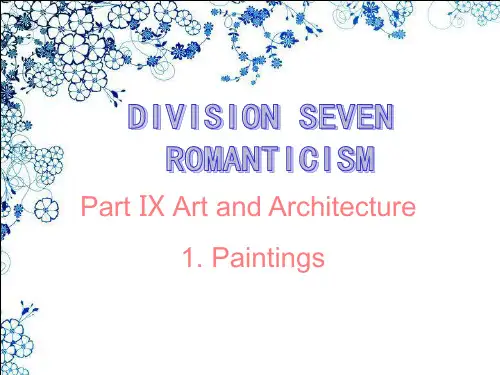
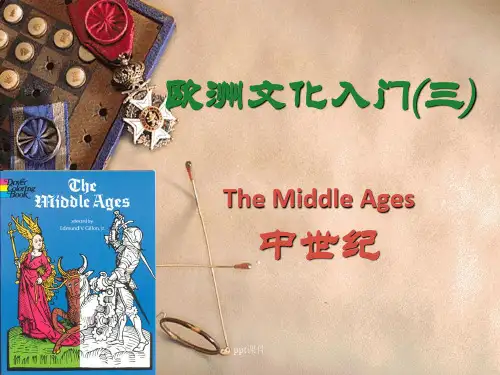
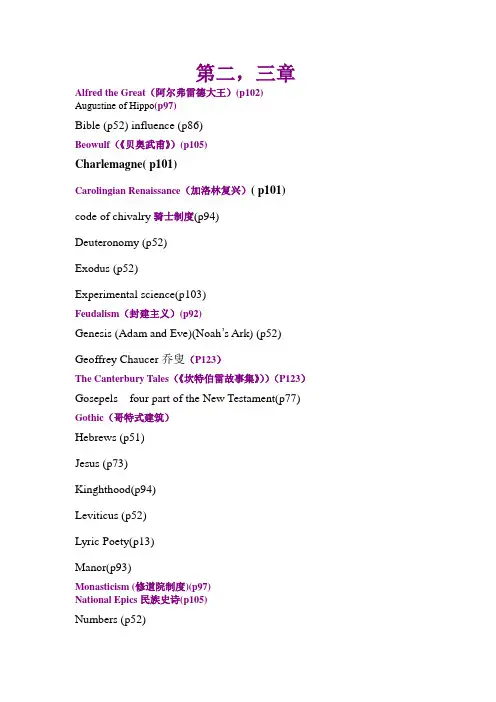
第二,三章Alfred the Great(阿尔弗雷德大王)(p102) Augustine of Hippo(p97)Bible (p52) influence (p86)Beowulf(《贝奥武甫》)(p105)Charlemagne( p101)Carolingian Renaissance(加洛林复兴)( p101) code of chivalry骑士制度(p94)Deuteronomy (p52)Exodus (p52)Experimental science(p103)Feudalism(封建主义)(p92)Genesis (Adam and Eve)(Noah’s Ark) (p52) Geoffrey Chaucer乔叟(P123)The Canterbury Tales(《坎特伯雷故事集》))(P123)Gosepels four part of the New Testament(p77) Gothic(哥特式建筑)Hebrews (p51)Jesus (p73)Kinghthood(p94)Leviticus (p52)Lyric Poety(p13)Manor(p93)Monasticism (修道院制度)(p97)National Epics民族史诗(p105)Numbers (p52)Peter and Paul (P74)Pentateuch (p52)Pindar(ode on athletic game) (p13)Roger Bacon培根(103)占星术炼金术Romansque(p126)Sappho (p13)Lyric PoetrySong of Roland (《罗兰之歌》)(P111)St. Jerome(p97)St. Benedict(p97)St. Thomas Aquinas(p102)Ten Commandments (Peuteronomys) (p60)The Catholic Church(天主教)(the power and influence)(p98) The church in middle ages(p95)The Crucifixion(p83)The Crusades(十字军东征)(p99)the Middle agesThe Sermon on tjhe Mount(p79)第四章Albrecht Durer[p168]\\Amerigo V espucci[p180]Andreas V esalius(1514-1564)[p181]Aldus Manutius[p181]Bartholomeu dias[p180]Counter-Reformation(反宗教改革)(p149)Christopher Columbus哥伦布[p180]Calvinism(加尔文主义)(p147)(p151)Council of Trent特伦托会议(p149)Dante但丁[p182]Donatello(p137)(sculptor)Don Quixote 《堂吉诃德》(p162)El Greco埃尔。
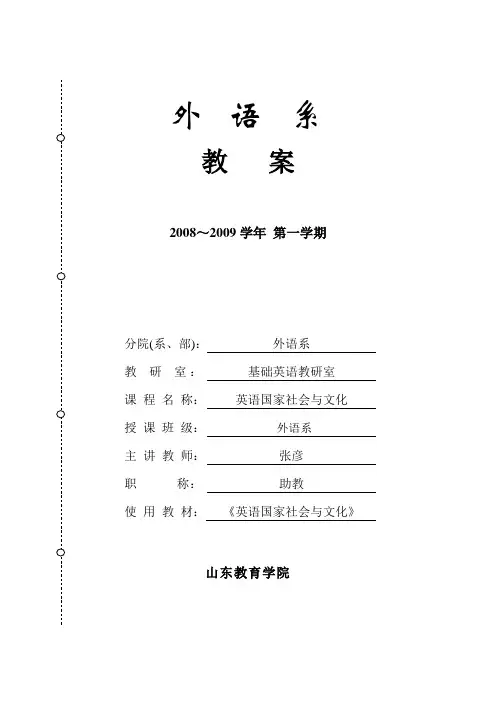
![欧洲文化入门Europe Culture3 The Middle Ages[精]](https://uimg.taocdn.com/474b82e26529647d272852ad.webp)
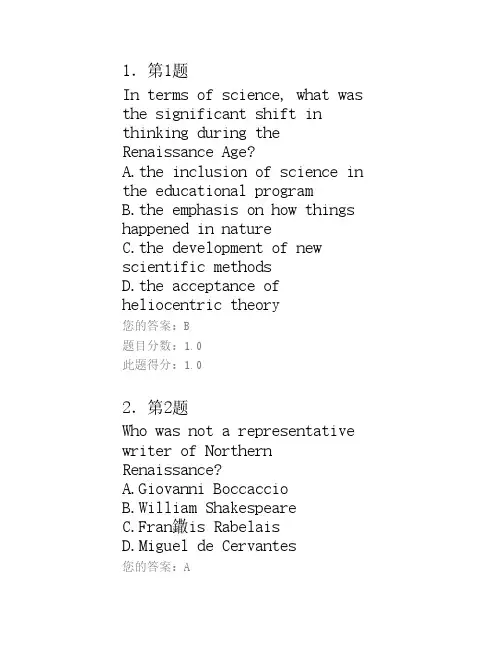
1.第1题In terms of science, what was the significant shift in thinking during the Renaissance Age?A.the inclusion of science in the educational programB.the emphasis on how things happened in natureC.the development of new scientific methodsD.the acceptance of heliocentric theory您的答案:B题目分数:1.0此题得分:1.02.第2题Who was not a representative writer of Northern Renaissance?A.Giovanni BoccaccioB.William ShakespeareC.Fran鏾is RabelaisD.Miguel de Cervantes您的答案:A题目分数:1.0此题得分:1.03.第3题Which categories ofpublication does Erasmus’s The Praise of Folly belong to?A.clever satires to expose people’s errorsB.serious moral books to offer people Christian guidanceC.scholarly editions of basic Christian textsD.collection of stories to amuse people您的答案:A题目分数:1.0此题得分:1.04.第4题Who was not one of the three masters of the High Renaissance art?A.Leonardo da VinciB.RaphaelC.El GrecoD.Michelangelo您的答案:C题目分数:1.0此题得分:1.05.第5题Which is not one of the three great achievements of Italian Renaissance art?A.the revival of classical textsB.the discovery of linear perspectiveC.the knowledge of anatomyD.the knowledge of the classical forms您的答案:A题目分数:1.0此题得分:1.06.第6题Which description of Petrarch is wrong?A.He was known as the “father of humanism”.B.He was the first to coin theterm “Dark Ages”.C.He valued his Italian writings more than his Latin writings.D.He was financed by Galeazzo II Visconti.您的答案:C题目分数:1.0此题得分:1.07.第7题Which is not one of the things that the Viscontis, the Sforzas and the Medicis had in common?A.They were wealthy and powerful families in Italy.B.They were rulers of Milan during the Renaissance.C.They ordered the construction of great architectures.D.They were generous patrons of artists and intellectuals.您的答案:B题目分数:1.0此题得分:1.08.第8题Three of the following statements are true with the Jesuits. Which one is the exception?A.They were highly respected for their learning and the purity of their lives.B.They became the principal university teachers in all European countries.C.They helped to stop the spread of Lutheranism into south Germany.D.They helped to spread Catholicism to the countries beyond Europe.您的答案:B题目分数:1.0此题得分:1.09.第9题Three of the following statements are true with theCouncil of Trent. Which one is the exception?A.It was first a religious meeting called to win back the Protestants.B.It condemned the scandals arising from the sale of indulgences.C.It insisted on Catholic tradition as the mere source of authority.D.It marks the beginning of the history of modern Catholic Church.您的答案:C题目分数:1.0此题得分:1.010.第10题Three of the following statements are true with England after the death of Henry VIII. Which one is the exception?A.The council of regents to rule England was dominated by reformers.B.Edward VI was enthusiastic about reform as Henry VIII had been.C.Edward VI was raised by Protestants rich with Renaissance ideas.D.Mary succeeded Edward VI and began to restore the Catholic faith.您的答案:B题目分数:1.0此题得分:1.011.第11题Three of the following statements are true with Henry VIII. Which one is the exception?A.He married his brother’s widow against Roman Catholic rules.B.He married his brother’s widow with the Pope' s authorization.C.He was eager to divorce the queen to end the poor marriage.D.He was eager to have a new marriage to bring him a male heir.您的答案:C题目分数:1.0此题得分:1.012.第12题Like Luther, Calvin____________A.believed man, from birth, is predestined by God for salvation or damnation.B.believed that the order and discipline of the early church should be restored.C.regarded the Bible as the only source of truth and spiritual authority.D.regarded the church as a place to be with God by reading the Bible.您的答案:C题目分数:1.0此题得分:1.013.第13题Luther made the first attempt to draw attention to the corruption of the Church in_______.A.The Liberty of the Christian ManB.Address to the Nobility of the German NationC.The Babylonian Captivity of the ChurchD.the Ninety-Five Theses您的答案:D题目分数:1.0此题得分:1.014.第14题Luther attacked the beliefthat the sacramental system was the only means tosalvation and called for the reform of monasticism in________________.A.The Liberty of the Christian ManB.Address to the Nobility ofthe German NationC.The Babylonian Captivity of the ChurchD.the Ninety-Five Theses您的答案:C题目分数:1.0此题得分:1.015.第15题Which of the following is true about the central argument of the Ninety-Five Theses?A.The Ninety-Five Theses marks the beginning of the Reformation.B.It was an effort to draw attention to the corruption of the Church.C.Repentance has the same power of the pope to forgive sins.D.The sale of indulgences went against the true spirit of Christianity.您的答案:D题目分数:1.0此题得分:1.016.第16题Three of the following statements are true with the early experience of Luther. Which one is the exception? A.Luther lived up to hisfather and became a priest. B.Luther had a horrible experience in a thunderstorm.C.He tried his best to get rid of his sin to satisfy God.D.He damaged his health by eating and sleeping less.您的答案:A题目分数:1.0此题得分:1.017.第17题Which of the following facts is NOT true with the situation in the Church of Rome before the Reformation?A.The sale of Church offices to wealthy families.B.The sale of indulgences toindividual believers.C.Some clegymen held several positions at the same time.D.Clergymen must meet strict moral and educational standards.您的答案:D题目分数:1.0此题得分:1.018.第28题The most immediate effect of the Reformation was___________________.A.the increase in the power of princes and kingsB.the more and more secularized western EuropeC.the outburst of fighting among religious groupsD.the more emphasis on the value of the individual您的答案:C题目分数:4.0此题得分:4.019.第29题Which statement about the humanist education during the Renaissance is wrong?A.The goal of education was to produce independent, virtuous and capable men who excelled in many different fields.B.The program of study relied heavily on classical training, but it also contained many other subjects.C.The Renaissance education enhanced the impact of the humanist ideas on the ruling class and the elite.D.The educational program of the humanists placed a high value on science.您的答案:D题目分数:4.0此题得分:4.020.第30题Three of the following statements are true withLuther's teachings. Which one is the exception?A.A priest of the Church never helps.B.A priest of the Church is only the teacher.C.The truth is only to be found in the Bible.D.Every believer is a priest of his own.您的答案:A题目分数:4.0此题得分:4.021.第31题The reasons for Henry’s reform in England were mainly ________.A.religiousB.personalC.politicalD.both B and C您的答案:D题目分数:1.0此题得分:1.022.第32题The successful spread of Lutheranism in the Holy Roman Empire is due to three of the following facts. Which one is the exception?A.The unstable political situation in the Holy Roman Empire.B.Public discontent caused by high papal taxes on Germans.C.Extreme anger in Germany against the power of the pope.D.Luther' s intention to extend his doctrine of social equality.您的答案:D题目分数:1.0此题得分:1.023.第33题Luther further explained his doctrine of faith and justification in______________.A.The Liberty of the ChristianManB.Address to the Nobility of the German NationC.The Babylonian Captivity of the ChurchD.the Ninety-Five Theses您的答案:A题目分数:1.0此题得分:1.024.第34题Luther called on the German princes to reject the foreign pope’s authority andestablish a reformed German church in _____________.A.The Liberty of the Christian ManB.Address to the Nobility of the German NationC.The Babylonian Captivity of the ChurchD.the Ninety-Five Theses您的答案:B题目分数:1.0此题得分:1.025.第35题Which of the following is true about Luther’s discovery from reading the Bible?A.His own individual faith would guarantee his salvation.B.Saint Peter’s guidance would guarantee his salvation.C.Saint Paul’s instructions would guarantee his salvation.D.Jesus Christ ’s teachings would guarantee his salvation.您的答案:A题目分数:1.0此题得分:1.026.第36题Which of the following statements is NOT true with the text?A.Martin Luther was a German missionary.B.Martin was declared an outlaw in the Empire.C.The Pope condemned Martin Luther’s beliefs.D.The Pope ordered Luther to change his beliefs.您的答案:D题目分数:1.0此题得分:1.027.第47题Which description of the Age of Renaissance is correct? A.The Renaissance happened right after the Late Middle Ages in time.B.The Renaissance reached a peak at the end of the sixteenth century.C.The Renaissance began as a literary movement.D.The Renaissance was opposed to humanism.您的答案:C题目分数:4.0此题得分:4.028.第48题Which is not the similarityshared by Chaucer’s Canterbury Tales and Boccaccio’s Decameron?A.a collection of storiesB.satirical and humorous languageC.vivid characterizationD.religious themes您的答案:D题目分数:4.0此题得分:4.029.第49题Which statement about the “civic humanism” is wrong?A.It was developed by some Florentine scholars during the fifteenth century.B.It believed that virtue could only be obtained by participating in public life.C.It encouraged people to pursue material pleasures and fulfill their desires.D.It was the same with the “Christian Humanism” ofNorthern Renaissance.您的答案:D题目分数:4.0此题得分:4.030.第50题Compared with Italian Renaissance, Northern Renaissance had the following distinctive features exceptfor ______.A.strong national flavorB.great religious concernC.influence of classicismD.belief in Christian humanism您的答案:C题目分数:4.0此题得分:4.031.第51题Which one is not the main characteristic of Shakespeare as a Renaissance man?A.His interest in classical cultureB.His belief in humanismC.His support of individualismD.His consciousness ofnational identity您的答案:D题目分数:1.0此题得分:1.032.第52题Which is the key feature of the Mannerism of the Late Renaissance art?A.the invention of newartistic techniquesB.the imitation of Greek and Roman stylesC.the representation of idealized human figuresD.the use of intense colors, strange themes and twisted figures.您的答案:D题目分数:1.0此题得分:1.033.第53题Who did not belong to theFlorentine School of the Early Renaissance art?A.BrunelleschiB.DonatelloC.MasaccioD.Raphael您的答案:D题目分数:1.0此题得分:1.034.第54题Which one is not a period of Italian Renaissance Art?A.Early RenaissanceB.Middle RenaissanceC.High Renaissancete Renaissance您的答案:B题目分数:1.0此题得分:1.035.第55题Which of the following Renaissance writers was not known for his sonnets?A.DanteB.PetrarchC.Edmund SpencerD.William Shakespeare您的答案:A题目分数:1.0此题得分:1.036.第56题The Italian Renaissance scholars did all the following things except for ____.A.reviving many classicaltexts forgotten or lost for a long time.B.spreading the knowledge beyond the small circle of scholars.C.refusing to accept religious teaching or read religious works.D.paying more attention to man’s world and life on earth.您的答案:C题目分数:1.0此题得分:1.037.第57题Three of the following statements are true with the Elizabethan Compromise. Which one is the exception?A.The Church of England again rejected the authority of the pope.B.The Church of England began to compromise with the Papacy.C.Elizabeth again condemned Catholic teachings and practices.D.Elizabeth,as a protestant, also forbade extreme Protestantism.您的答案:B题目分数:1.0此题得分:1.038.第58题Three of the following statements are true with the Catholic Counter-Reformation.Which one is the exception?A.It was in nature a reaction to Protestantism.B.It was the result of Catholic self-criticism.C.It resulted from the Protestant Reformation.D.It resulted from a Church-wide call for reform.您的答案:B题目分数:1.0此题得分:1.039.第59题Who was not a believer in the heliocentric theory?A.Nicolas CopernicusB.Johannes KeplerC.GalileoD.Francis Bacon您的答案:D题目分数:1.0此题得分:1.040.第60题Who was regarded as the“father of oil painting”?A.MasaccioB.BotticelliC.Albrecht D黵erD.Jan van Eyck您的答案:D题目分数:1.0此题得分:1.041.第18题“Middle English” was the national language of the England during the Early Middle Ages.您的答案:错误题目分数:2.0此题得分:2.042.第19题During the Renaissance, all scholars and artists abandoned medieval qualities and embraced modern values over night.您的答案:错误题目分数:2.0此题得分:2.043.第20题During the Renaissance, many Italian scholars began to learn Greek because they wanted to translate Latin works into Greek.您的答案:错误题目分数:2.0此题得分:2.044.第21题Florence was the major centre of the High Renaissance Art at the early 16th century.您的答案:错误题目分数:2.0此题得分:2.045.第22题Due to the Protestant Reformation and the Catholic Counter-Reformation, the Church of Rome lost its authority to settle alldisputes among Christians.您的答案:正确题目分数:2.0此题得分:2.046.第23题The sales of Church offices led to low religious and personal standards of the clergymen.您的答案:正确题目分数:2.0此题得分:2.047.第24题According to Luther, the Bible was the only source ofpolitical and religious authority.您的答案:正确题目分数:2.0此题得分:2.048.第25题In the Middle Ages, Christiansin Western Europe only needed to pay one tenth of their annual income to the Church of Rome.您的答案:错误题目分数:2.0此题得分:2.049.第26题The Holy Roman Emperor Charles V helped the Pope in the movement of Catholic Counter-Reformation.您的答案:错误题目分数:2.0此题得分:2.050.第27题By the 15th century the Pope had become powerful in both the secular life of the Europeans as well as in their religious life.您的答案:正确题目分数:2.0此题得分:2.051.第37题Marsilio Ficino, the first man to translate Plato’s complete works from Greek into Latin, was known as a Neo-Platonist.您的答案:正确题目分数:2.0此题得分:2.052.第38题The Northern Renaissance is the term used to describe the Renaissance in northern Europe, or more broadly in Europe outside Italy.您的答案:正确题目分数:2.0此题得分:2.053.第39题Dante was the first Italian writer to compose in his native language rather than in Latin.您的答案:正确题目分数:1.0此题得分:1.054.第40题The Italian Renaissance was largely credited to the economic success in Italy at that time.您的答案:正确题目分数:2.0此题得分:2.055.第41题All city-states of northern Italy belonged to the Holy Roman Empire during the Renaissance.您的答案:错误题目分数:2.0此题得分:2.056.第42题Reading of the Bible and his theological teaching madeclearer Luther’s idea about the malpractices of the Church.您的答案:正确题目分数:2.0此题得分:2.057.第43题It was only in the 16th century that the Church of Rome’s monopoly began to meet the challenge for religious reform.您的答案:错误题目分数:2.0此题得分:2.058.第44题To allow a person to buy God’s forgiveness and ransom his way out of hell, the Church developed the sale of indulgences.您的答案:正确题目分数:2.0此题得分:2.059.第45题Christian Humanism helped pave the way for the Protestant Reformation.您的答案:正确题目分数:2.0此题得分:2.060.第46题Martin Luther first expressed his idea of reforming the Church by criticizing the sale of indulgences.您的答案:正确题目分数:2.0此题得分:2.0。
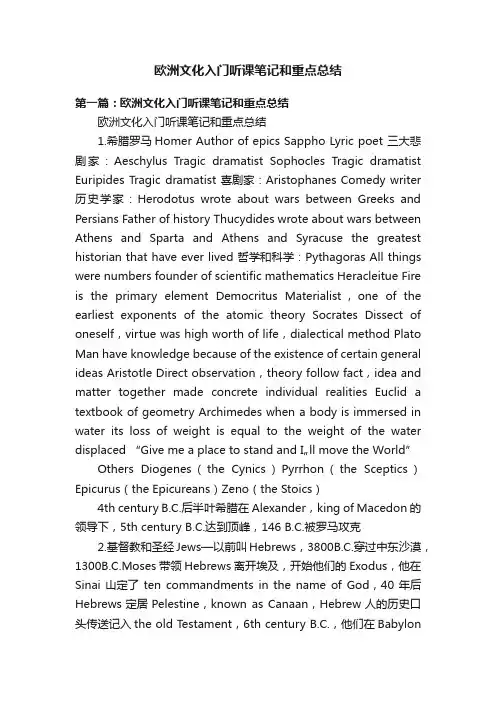
欧洲文化入门听课笔记和重点总结第一篇:欧洲文化入门听课笔记和重点总结欧洲文化入门听课笔记和重点总结1.希腊罗马Homer Author of epics Sappho Lyric poet 三大悲剧家:Aeschylus Tragic dramatist Sophocles Tragic dramatist Euripides Tragic dramatist 喜剧家:Aristophanes Comedy writer 历史学家:Herodotus wrote about wars between Greeks and Persians Father of history Thucydides wrote about wars between Athens and Sparta and Athens and Syracuse the greatest historian that have ever lived 哲学和科学:Pythagoras All things were numbers founder of scientific mathematics Heracleitue Fire is the primary element Democritus Materialist,one of the earliest exponents of the atomic theory Socrates Dissect of oneself,virtue was high worth of life,dialectical method Plato Man have knowledge because of the existence of certain general ideas Aristotle Direct observation,theory follow fact,idea and matter together made concrete individual realities Euclid a textbook of geometry Archimedes when a body is immersed in water its loss of weight is equal to the weight of the water displaced “Give me a place to stand and I…ll move the World”Others Diogenes(the Cynics)Pyrrhon(the Sceptics)Epicurus(the Epicureans)Zeno(the Stoics)4th century B.C.后半叶希腊在Alexander,king of Macedon的领导下,5th century B.C.达到顶峰,146 B.C.被罗马攻克2.基督教和圣经Jews—以前叫Hebrews,3800B.C.穿过中东沙漠,1300B.C.Moses带领Hebrews离开埃及,开始他们的Exodus,他在Sinai山定了ten commandments in the name of God,40年后Hebrews定居Pelestine,known as Canaan,Hebrew人的历史口头传送记入the old Testament,6th century B.C.,他们在Babylon形成synagogue(忧太集会)来发扬他们的教义。
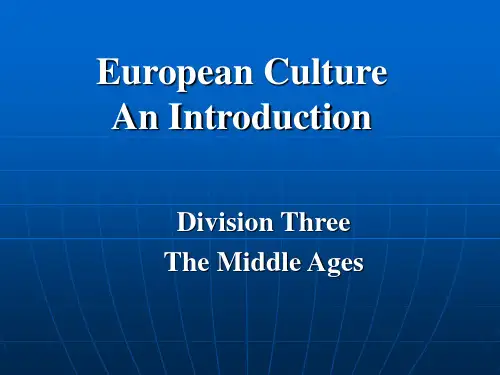
欧洲文化入门考点总结[中文版]《欧洲文化入门》由于其内容庞杂,琐碎,因而是一门学习起来比较困难的课程。
我们要牢记文化的五分法:一、社会历史(包括政治、经济、宗教、历史) 二、哲学三、文学四、科学五、艺术(包括绘画、雕塑、建筑和音乐),以记忆每个时代的各要点为主,理解纵向的变迁为辅,后者主要的作用时帮助我们更好的记住前者。
第一章希腊罗马文化希腊罗马文化可以说是欧洲文明的起源,所以这一章节应该是比较重要的章节.我们先看希腊的发展.希腊文明分为几个时期,她形成于公元前800-500年,经历了古典时代(也就是公元前500到公元前336年)和希腊化时代(也就是公元前336年到公元前31年).希腊文明达到顶峰是公元前5世纪.公元前146年,希腊被罗马攻克.希腊文明也就被罗马文明所取代.这段历史的重要大事有:1,公元前12世纪,随着特洛伊人的入侵,荷马史诗描述的正是希腊人与特洛伊人之间的战争(《以利亚特》和《奥得赛》).这里要注意的是,荷马史诗描述的时代并非荷马生活的时代.荷马生活在公元前700年.2,公元前6世纪,希腊世界开始有了全面改变,为后来的古典时代打开了通途.其中两个重要的城邦国家是雅典和斯巴达.雅典发展起一个完全不同类型的社会,公元前594年,梭伦成为雅典的首席执行官,他的贡献在于,在组织上为以后建立著名的雅典民主奠定了基础.雅典之所以在当时拥有卓越的地位,是因为它在打败庞大的波斯帝国这场重大战争中起了最主要的作用.历史之父希罗多德在他的历史书中进行了详尽的描述.3,由于雅典的不断扩张引起了斯巴达的恐慌,因而在公元前431年爆发了伯罗奔尼撒战争.战争最终以雅典的失败而告终.修昔底得这位历史上最伟大的历史学家在其作品中,详尽描写了这一战争.4,伯罗奔尼撒战争后,斯巴达专横跋扈,底比斯和雅典为求相互保护而结成新的联盟.公元前371年,马其顿国王腓力二世打败了底比斯和雅典联军,他的闻名世界的儿子亚历山大大帝统治了希腊.至此,古典时代结束,希腊化时代即将开始.古典时代的希腊造就了一批哲学家和剧作家.哲学家主要以苏格拉底,柏拉图和亚里士多德为代表.苏格拉底提出自由辩论的重要性.柏拉图的目标是要实现一个既能维持贵族特权,又可为贫苦阶级接受的社会,并构件了唯心主义的根基.亚力士多德寻求自然界和人类社会各个方面的秩序.剧作家有埃斯库罗斯,阿里斯托芬,索福克勒斯.这一时期希腊也造就了像阿基米德和欧几里得这样的数学家,以及像希罗多德和修昔底得这样伟大的历史学家.希腊的艺术和建筑在神庙上得到最高体现.著名的雅典卫城的圣地帕台侬神庙就是卫雅典娜女神建造的.接下来我们从希腊文明走向罗马文明.希腊化时代与罗马时代前期相互交融,最终过渡到罗马时代.罗马时代经历了早期共和国(公元前509-公元前264年),后期共和国(公元前265-公元前27年),早期帝国(公元前27年-公元284年)和后期帝国(284-476年).公元前500年,罗马开始了独立城邦的生涯.经过三次布诺战争,罗马渐渐地满足了它的征服欲.战争中尤里乌斯恺撒声名鹊起.公元前27年,元老院授予屋大维"奥古斯都"和"大元帅"的尊称,罗马早期帝国形成.在此后的两个世纪中,罗马帝国的疆域达到最大范围,其文化处于极盛时期.这段历史时期被成为"罗马和平".但罗马的伟大也就仅至于此.罗马的伟大时代随着公元180年马可奥勒留的去世而告终.公元395年,罗马帝国彻底分裂为东罗马帝国和西罗马帝国.公元476年,西罗马帝国陷落.公元1453年,东罗马帝国被土耳其人占领.说到罗马的文化,它基本源于希腊,但罗马人在思想意识方面也有重大贡献.罗马人对欧洲文化所作的最重要的贡献是它所创立的罗马法律.在政治文化方面,罗马出现了以下比较重要的人物:1. 恺撒他是古代罗马政治家,军事家.他在文学方面也颇有建树.传世之作有《高卢战记》,《内战记》.对于他,我们要记住一句名言:也就是"I came, I saw, I conquered."2.西赛罗他是古罗马政治家,哲学家和最重要的演说家.主要成就在演说词和书信.3. 卢克来修他是罗马共和国末期主要诗人之一,提倡唯物论,无神论和原子论.作品有哲理诗《物性论》.4. 维吉尔他是罗马文学中最重要的作家.代表作品是《阿尼德》.在建筑,艺术方面,罗马人也做出了突出的贡献.如:圆形大剧场和建于公元前27年的罗马万神殿以及女狼雕塑等.以上是对希腊罗马文化的综述,下面我们来一起看两个问答题.1. How did the Ancient Greek philosophy develop 希腊哲学是如何发展起来的回答这个问题,我们要掌握 1. 三个哲学奠基人及其理论:毕达哥拉斯,赫拉克里特,德谟克里特.2. 三位思想家及其理论:苏格拉底,柏拉图和亚力士多德.3. 其它思辩流派,如诡辩派,犬儒派等.这样才能完善这个问题.具体的答案我们可在练习册上找到.2. What's the difference between Plato and Aristotle in terms of their philosophical ideas (system) 柏拉图和亚力士多德的哲学体系有何区别回答这个问题,首先要阐述柏拉图的哲学体系包含什么,亚力士多德的哲学体系包含什么.然后再进行对比.他们两个最主要的一个区别在于亚力士多德强调理论联系实际,而柏拉图强调万物依赖主观思维.这是必须提到的一点.具体的答案见练习册.以上是对第一章希腊罗马文化的讲解.刚才我们谈到要研究欧洲发展的历史,除了要研究希腊和罗马文化历史这条线索之外,精神宗教形成线索,即犹太教和基督教历史也很重要. 在第二章中我们要看一下基督教和圣经的发展及其内容.第二章基督教和圣经这一章的重点是:犹太教与基督教的关系,基督教的教义核心,旧约的摩西五经,十诫,列王记,罗马帝国衰亡的原因,基督教与罗马帝国政府的关系的发展,基督教教士对维系和发展西方文明的贡献,圣经对西方的影响或贡献.在学习这一章中,大家应努力将2-4章关于基督教的知识连成线,从而理解和记忆欧洲文化的另一个重要源头的发展脉络――犹太教和基督教,彻底认清圣经在欧洲文化中的核心作用. 基督教是在西方最具影响力的宗教.犹太教是世界各地犹太人信仰的宗教.是基督教的前身.这一教派的经典《旧约》记载了犹太人的历史.犹太人以前叫Hebrews希伯莱人,在大约公元前3800前在中东一带沙漠流浪.约在公元前1300前,他们逐渐在伽南地区定居下来,并形成了小王国.基督教与犹太教关系密切.它与犹太教同发源于巴勒斯坦.基督教的核心是耶稣基督,其教义是:一,耶稣基督是上帝的儿子,上帝派他到人间来,跟人类一起受苦受难,最终拯救人类.二,基督是上帝唯一的儿子,任何信仰基督的人最终得到永生.耶稣基督生活在第一个罗马帝国.他教导人们热爱上帝,信仰上帝.由于他获得越来越多的人的爱戴,当时的统治者就收买了他十二个门徒中的犹大,在耶稣与他的弟子去往巴勒斯坦的路上,将他钉死在十字架上.由于耶稣的门徒圣保罗和圣彼得拒绝把罗马皇帝作为上帝来敬奉,而宣称只有真正的上帝才能受到崇拜,所以基督教一开始就被认为是一个具有反叛性的宗教受到包括罗马皇帝尼禄,多米提安在内的皇帝的迫害的宗教.尽管如此,基督教还是越来越受到人们的信奉,并开始从早期穷人信奉的宗教演变为各个阶层的人都能接受的宗教.成为一支显著的社会力量.统治者对它的态度也开始转变.公元305年,戴克里先放弃了摧毁基督教的企图.不久,君士坦丁一世由于相信上帝帮助他赢得战争而在313年发布"米兰赦令"宣布人人都有宗教信仰的自由,从此基督教取得了合法地位.392年,迪奥多西一世宣布基督教为罗马国教,而其它宗教不合法.至此,基督教从一个受压迫的对象转变为统治阶级的统治武器.基督教的主要经典是《圣经》.《圣经》由《新约》和《旧约》两部分构成.在前面已经谈到《旧约》是希伯莱人的文献.《旧约》共39部,写了从1000B.C.---100A.D.的事情,最重要的前五本是《摩西五书》,包括《创世纪》, 《出埃及记》, 《利未记》, 《民数记》, 《申命记》.《新约》成于基督教兴起之后,共27卷,其中前四卷福音书《马太福音》,《马可福音》《路加福音》《约翰福音》内容包括了有关耶稣言行的传说,耶稣使徒的传说.接下来我们看一下《圣经》的翻译:现存的最早的《旧约》希腊版本被成为旧约圣经.传说是应埃及王之请,由72位犹太学者在72日之内译成.现存最早的《圣经》拉丁文全译本是瓦尔盖特译本,是公元383-405年由圣杰罗姆所译,是罗马天主教认为唯一可信的拉丁语译本.其它英文译本及欧洲其它语种译本大都以瓦尔盖特译本为基础.当1500's发明印刷术时,拉丁圣经是第一部被全文印刷的作品. 继拉丁文译本之后,出现了现代语言的译本.第一部英文全文译本是1382年由约翰威克利夫在瓦尔盖特拉丁文译本基础上译成.之后,出现了英国宗教改革家丁道儿的英文译本.他的译本是直接根据希伯莱和希腊原文译成.后来出现的《大圣经》The Great Bible 就部分参照丁道儿的译本.1539年在亨利八世命令所有英国教堂中都必须供奉《大圣经》.但最重要的也是最具影响力的圣经译本是最初发表于1611年的官方版圣经或詹姆斯王圣经. 它的翻译是在詹姆斯国王的命令下由54为圣经学者翻译而成,语言简洁,使用高雅的安各鲁萨克森语言.这一译本被认为是英语语言中最伟大的作品.圣经修订本The Revised Version 出现在1885,1901年出现了标准美语版本圣经修订本.1979年,新版詹姆斯王圣经出版.对圣经的翻译有重大意义,英语圣经和莎士比亚的作品被成为现代英语的两大源头.后世的文学深受圣经的影响.如:Miltion's Paradise Lost (失乐园), Bunyan's Pilgrim's Progress, Byron's Cain, up to the contemporary (同时期的) Hemingway's The Sun Also Rises, and Steinbeck's East of Eden. They are not influenced without the effect of the Bible.以上是对希腊罗马文化的综述,下面我们来一起看一个问答题.1. How was Christianity spread to Europe and became the official religion基督教是如何传到欧洲并成为统治性宗教?其实这个问题我们在综述总已经谈到.只要搞清基督教发展的历史阶段,每一阶段的社会状况,它为什么会从被迫害变成成为统治阶级的工具,统治阶级又是如何一步步将它从摈弃,迫害变为合法,变为国教的就可以了.这其中的重要人物是戴克里先,君士坦丁一世,迪奥多西一世.下面我们进行第三章,中世纪the Middle Ages.第三章中世纪The Middle Ages本章重点:封建土地制和分封制,天主教会的影响(包括教会组织,教会学术和哲学,教会艺术,教会影响),三种文化的融合,民族文学. 在学习这一章中,很多题目的内容相互交叠,互有异同,请反复研读,只需将骨干内容搞清楚,相似的题目的核心答案往往是一致的. 下面我们一起来看一下中世纪的内容.中世纪开始于476年日耳曼人将西罗马帝国的灭亡.这一年也被认为是欧洲古代奴隶制社会历史的终结.从这时起,直到17世纪中叶英国资产阶级革命爆发,是欧洲历史上的中世纪.中世纪是欧洲封建制度形成,发展和衰亡的历史.欧洲历史的中世纪大致可分为三个时期.公元5-11世纪为初期,是封建社会形成时期;公元12-15是中世纪的中期,也是它的全盛时期;公元16-17世纪是中世纪的末期,是封建社会衰落瓦解和资本主义兴起的时期.中世纪的最初几个世纪是在混战的状况中.在日耳曼人建立的王国中,以六世纪法兰克王国最强大.公元8世纪末和九世纪初,法兰克国王查理曼大帝建立了强大的帝国.查理曼国王在1800年被教皇加冕,授予"罗马皇帝"之称.查理曼大帝应该说是中世纪早期最重要的人物了.从11世纪起,西方随着经济的迅速发展,国家君主国崛起,新的知识水平的出现,扩张主义盛行――首先是地方的十字军东侵,然后是向海外推进,在数世纪内导致全球性霸权.而东罗马帝国经过长久的挣扎之后,注定了1453年的灭亡.中世纪的封建土地所有制feudalism是欧洲各地区的主要的政治制度.封建制度是一种政体,在这一政体中,那些拥有地产的人也拥有政权,因此,封建主和封臣之间的契约代替了国家权利.大多数时间里掌握国家政权的是那些封臣们而不是国王.这些强有力的封建领主(vassals)在把他们的封地分成更小的封地(fiefs),分给他们的追随者们.当时最基本的经济组织是封建庄园(manor),农奴依附在庄园领主的土地上,被迫无偿为他们劳动.公元1054年,基督教教会分裂为罗马天主教(the Roman Catholic Church)和东正教(the Eastern Orthodox).罗马天主教将拉丁语作为正式语言.中世纪时期,几乎所有欧洲人都信奉罗马天主教.因此,中世纪也被成为"信仰时代"(Age of Faith).天主教会有严格的等级之分.教皇(Pope)享有绝对的权威,以下以此为大主教(Archbishop),主教(bishop),牧师(Priest)和天主教会现有成员,教会有严密的组织和纪律.隐修院制度产生于这一时期,并培养了大批的修道士,比如,将圣经全文译成英文的圣杰罗姆以及于公元529年创立本尼狄克法则的圣本尼狄克.基督教思想一个最重要的领袖人物是公元5世纪的奥古斯丁.他对基督教神学思想产生了深远的影响.《忏悔录》和《上帝之城》是他的两部不朽的著作.基督教在欧洲封建社会的政治生活中起着十分重要的作用.原来在罗马帝国时期为奴隶主统治服务的基督教到了中世纪自然地变做封建主统治的重要工具,成为封建制度的精神支柱.基督教世界排斥异己,并且好战成性.其中当属十字军东侵(the Crusades)最为著名.尤其是对圣地巴勒斯坦几次入侵.虽然最后以失败告终,但却促进了东西方文化的交流,为君主政体的形成准备了条件.在学术和科学方面,中世纪的欧洲知识为即将道来的西方新兴世界作一些铺垫.查理曼大帝(Charlemagne)和他的卡罗林复兴(Carolingian Renaissance),阿尔弗莱德大帝(Alfred the Great)和他的学术中心,还有意大利神学家阿奎那(St. Thomas Aquinas)的经验哲学(Scholasticism)和托马斯主义,英国哲学家,科学家培根(Roger Bacon)的实践的重要意义,无一不对文化的保存与发展做出了巨大的贡献.在文学创作方面,出现了长篇的史诗(Epic).日耳曼人的一支盎格鲁萨克逊人的史诗《贝欧伍尔夫》是流传至今的早期英雄史诗最完整的一部.而《罗兰之歌》则是法国史诗中最著名的. 中世纪还产生了两位伟大的诗人――但丁和乔叟.意大利著名诗人但丁的《神曲》是世界文学史上的划时代的作品,表达了即将到来的文艺复兴时期的人文主义思想.英国诗人乔叟被称为英国文学史上第一位短篇小说家和第一位现代诗人,他最著名的作品是坎特伯雷故事集. 中世纪的建筑与艺术主要是罗马式的和哥特式的,他们都是古典艺术的延伸.以上是对中世纪内容的综述,下面我们来解答一道问答题.1. What were the power and influence of the Roman Catholic church in the Medieval times (the Catholic Church ) 罗马天主教在中世纪的影响地位如何回答这个问题我们从以下几个方面:1) 罗马天主教从教皇到教士的严格的层级制度和组织.2) 罗马天主教在经济上和政治上的统治地位,宗教裁判所的作用.3) 人们对罗马天主教信仰度,也就是为什么中世纪被叫做"信仰时代".4) 罗马天主教在文化艺术上的影响地位.比如哥特式建筑,罗马式建筑等.5) 十字军东侵所造成的影响.接下来共同学习一下第四章,文艺复兴和宗教改革.这也是欧洲文化入门中相当重要的一个章节.第四章文艺复兴与宗教改革本章重点有:科学背景,意大利文艺复兴的背景,意大利文艺复兴的文学和文艺大师,16世纪宗教改革,宗教改革领袖,英西法德荷诸国的文学人物及作品.这个时期是欧洲封建社会逐渐解体,资本主义生产方式在封建社会母体内蕴育的时期,也是欧洲从中世纪封建社会向资本主义过渡的历史转折时期.从十四世纪开始,欧洲封建社会陆续出现了资本主义关系的萌芽;十五世纪末,随着新航路的开辟和地理大发现,世界市场形成了,这就进一步推动了资本主义的发展.但,这时新兴的资产阶级在政治上还是软弱的,因而他们的反封建的斗争主要表现在思想文化方面.这一时期资产阶级反封建的思想斗争主要采取了两种方式:宗教改革和文艺复兴.文艺复兴是从十四世纪到十七世纪初先在意大利产生,然后在欧洲其它许多国家相继发展起来的一次资产阶级性质的思想文化运动.它是资产阶级借助于古代文化以反对封建制度和宗教势力的一次斗争.这一时期,古希腊,罗马文化重新受到重视,当时新兴资产阶级的思想家们打着"回到希腊去"的旗号,声称要把久被淹没的古典文化"复兴"起来,"文艺复兴"由此而得名.而实际上,资产阶级的目的不是重建奴隶制旧文化,而是要摆脱封建思想的桎梏,建立适应资本主义生产关系的新的意识形态.人文主义是文艺复兴时期资产阶级反封建斗争的思想武器,也是这一时期资产阶级进步文学的中心思想.与天主教会的宗教世界观针锋相对的是,人文主义提出人是宇宙的中心,对"人"的肯定,成了资产阶级思想的核心.宗教改革是资产阶级在宗教外衣下进行的一次反封建斗争.天主教会是中世纪西欧封建制度的精神支柱,一切反动势力的总代表.宗教改革是从教会营垒内部进行的针锋相对的斗争,它始于1517年马丁路德(Martin Luther)在维登堡大学宣布的宗教改革纲领,并迅速遍及欧洲大陆.宗教改革者反对以罗马教皇为首的罗马天主教的绝对权威,主张对宗教教义,仪式和等级制度进行改革,并提出将《圣经》翻译成各国文字,以使平民可以不通过教会而直接与上帝进行交流.宗教改革运动的另一领袖加尔文(John Calvin)宣扬预定论,主张人生来就有原罪,只有极少数人可以成为上帝的选民.因此人们必须不断地辛勤工作,从而获得拯救.宗教改革动摇了中世纪以来罗马天主教的统治,解放了人们的思想.那以后,基督教分裂为旧教(the Roman Catholic)与新教(the Protestant).同时,宗教改革也是一次社会改革运动,它反对罗马天主教对各国政治,经济的干涉.这一主张适应了新兴资产阶级的要求.下面我们来看一下文艺复兴在各国文学艺术上的体现.首先我们来看意大利.作为文艺复兴的发源地,意大利率先在文学艺术上取得了很大成就.这一时期,文学方面的杰出代表卜加丘(Boccaccio)和彼特拉克(Petrarch).卜加丘(Boccaccio)的代表作《十日谈》(Decameron)在欧洲文学史上具有重要意义,他发展了中古短篇故事的传统,为意大利散文奠定了基础.彼特拉克在诗歌方面做出了巨大贡献.他擅长并写下了大量的十四行诗和抒情诗.十四行诗成为欧洲的重要诗体,彼特拉克被称为现代诗歌之父.在艺术方面,文艺复兴早期的意大利艺术家有乔托(Giotto),布鲁内莱斯基(Brunelleschi),多纳泰洛(Donatello)和乔尔乔内(Giorgione)等.乔托(Giotto)是意大利现实主义绘画传统的奠基人,他的名作是《逃往埃及》(Flight into Egypt).布鲁内莱斯基(Brunelleschi)是一位建筑师,他的代表作弗洛伦萨大教堂圆顶.多纳泰洛(Donatello)的雕塑达到了解剖学的精确,代表作有青铜铜像《大卫》(David)《加塔梅拉塔骑马像》(The Gattamelata Equestrian).画家乔尔乔内(Giorgione)的画结构平衡,色彩和谐.他的名作是《睡着的维纳斯女神》(Sleeping Venus)开创了西方绘画中历久不衰的一个题材:裸体躺卧着的女神像.意大利文艺复兴在16世纪达到全盛时期,文艺的中心从弗洛伦萨转移到米兰和罗马.全盛时期产生了四位巨匠,他们是达芬奇(da Vinci)米开朗基罗(Michelangelo)拉斐尔(Raphael)和提香(Titian).达芬奇的传世之作《最后的晚餐》(the Last Supper),《蒙娜丽莎》(Mona Lisa),雕塑家米开朗基罗的大理石造像《大卫》,《即将死去的奴隶》,拉斐尔的圣母画,提香则是最多产的画家,建立了在帆布上涂油彩的传统,被誉为现代画之父.在意大利文艺复兴的影响下,15世纪末,法国人文主义开始研究古希腊文化和哲学,出现了龙沙(Ronsard)拉伯雷(Rabelais),蒙田(Montaigne)等伟大作家.拉伯雷的长篇小说《巨人传》(Gargantua and Pantagruel)以龙沙为代表的七星诗社(Pleiade)为法国的语言发展做出了很大贡献.龙沙诗法国第一个近代抒情诗人,他对19世纪法国浪漫主义有着很大的影响.人文主义作家蒙田以他的《散文集》而闻名于世,他是近代欧洲散文体裁的创始人.西班牙人文主义发展较迟,直到16,17世纪之间,西班牙文学才进入"黄金时代".文艺复兴时期西班牙小说的最高成就是塞万提斯,他的代表作《唐吉珂德》宣告了骑士传奇的终结.《唐吉珂德》是流浪汉小说的典范之作,被誉为欧洲现代小说之父.北部领导荷兰尼德兰人文主义运动的人物是埃拉丝姆斯(Erasmus),他的《愚蠢颂》(The Praise of Folly)是部讽刺作品,揭露僧侣生活的虚伪.这一时期的画家是博鲁盖尔(Bruegel)以风景画著称,名作有《雪中猎人》(The Return of the Hunters).他的乡村风景画对后来的画家米勒(Millet)有很大影响.在德国,马丁路德是宗教改革的领袖,他用德国人民的语言翻译了《圣经》,使平民和农民能引用《圣经》的语言作为斗争的武器,对于德国语言的统一发生过作用,并奠定了德国文学语言的基础.在艺术方面,版画家丢勒(Durer)的木雕和荷尔拜因(Holbein)的肖像成就很高.英国文学是文艺复兴时期欧洲文学的顶峰.早在14世纪,英国就产生了人文主义作家杰弗利乔叟(Geoffery Chaucer),作为承上启下的人物,乔叟我们在中世纪文学中已经谈到.到16世纪后半期到17世纪初,英国在伊丽莎白一世在位时,人文主义文学发展到了繁荣时期.这一时期的文学巨匠不仅在英国文学中占有很重要的地位而且在世界文学中也举足轻重.他们是威廉莎士比亚,托马斯莫尔,弗兰西斯培根,埃德蒙斯宾赛.莫尔是早期人文主义作家,他的主要著作《乌托邦》描绘了一个理想社会.成为后来描写理想社会文学的开端,也是空想社会主义的最初著作之一.16世纪后期,英国文艺复兴运动达到高潮,人文主义文学空前发达.诗歌,小说,戏剧等都得到了很大发展.诗歌以斯宾赛的成就最高.他的代表作是长诗《仙后》.斯宾赛被成为"诗人的诗人".十六世纪文学中成就最大的是戏剧.而其中文学成就最高的是莎士比亚,他也代表了欧洲文艺复兴的最高成就.在他的作品中,资产阶级人文主义思想表述得最为充分,艺术性也最高.他的重要悲剧,戏剧和历史剧有《哈姆雷特》,《麦克白》,《奥赛罗》,《李尔王》,《威尼斯商人》,《第十二夜》,《皆大欢喜》,《罗米欧与朱丽叶》,《安东尼和克里奥帕特拉》,《亨利四世》,《亨利五世》等.他的诗歌成就也很高,这主要表现在他的《十四行诗》中.文艺复兴时期,科技也取得了重大进展.除了地理大发现以外,哥白尼发表了太阳中心说,并著有《天体运行论》,他被成为是西方现代天文学之父.安德勒斯维萨留斯(Andreas Vesalius)著有《论人体的结构》,他是西方现代解剖学的奠基人.此外还有在创办出版社的意大利学者和印刷商奥尔德斯马努蒂尔乌斯(Aldus Manutius),西方政治学之父马基雅维里及其著作《君主论》.总之,文艺复兴是欧洲从中世纪封建社会向近代资本主义转变时期的反封建,反教会神权的一场伟大的思想解放运动.在这一时期,欧洲哲学,文学,艺术,科学等各方面都取得了极大的成就. 以上是对第四章的综述,下面我们来解答一下论述题.。
欧洲文化入门第一篇:欧洲文化入门《巴黎圣母院》读后感读完了《巴黎圣母院》,文中的丑与美,善与恶,在我的脑海里留下了挥之不去的印象。
《巴黎圣母院》是法国十九世纪著名作家维克多·雨果的浪漫主义长篇小说代表作,发表于1831年,小说描写了15世纪光怪陆离的巴黎生活,并透过这种描写深刻地剖析了丰富复杂的人性世界,表现了雨果的人道主义思想。
雨果在《巴黎圣母院》中用对比的手法刻画了群性格鲜明,极富有艺术感染力的人物形象,人物之间错综复杂的矛盾纠葛和悲剧命运扣人心弦。
给我留下的印象最为深刻的是一组对比鲜明,令人触目惊心的人物形象吉卜赛少女爱斯梅拉达和敲钟人卡西莫多。
16岁的爱斯梅拉达美貌绝伦,纯真善良,能歌善舞,她和她那只聪明绝顶的小山羊是整部小说中给人以无限遐想的浪漫亮点,是美丽和自由的化身。
但在禁欲的中世纪极端保守腐朽的教会势力的摧残下令人惋惜地陨灭了。
20岁的卡西莫多外貌其丑无比,严重的残疾使他一来到这个世界上,便遭到无情的遗弃——先是亲人的遗弃,继而是整个社会的遗弃。
然而外貌丑陋的卡西莫多却有着一顶纯洁美丽的心灵,他以纯真得不掺一丝杂质的爱情如同守护着珍宝一般守护着爱丝梅拉达,试图使她远离一切伤害。
但在强大的社会偏见和恶势力面前,个人的力量实在是微不足道,致使强悍的卡西莫多,也只有选择殉情这一悲剧。
这两个主人公存在着纠结在一起的不幸身世,外貌上的反差也无法掩盖他们共有的纯真善良的天性.。
在《巴黎圣母院》中,有着无数值得读者深思的句子,它不仅仅是现实人生的真实写照,而且通过真善美与假恶丑的鲜明对比,告知读者丰富的人生哲理:爱斯美拉达是一位能歌善舞的十六岁美女,由于从小被吉普塞人从家中偷走,在流浪艺人中长大,所以不被当时等级森严的上流社会所认同和接受。
当她在深夜被人打劫时,被英俊潇洒的皇家卫队队长弗比斯英雄救美,便一见钟情地陷入爱河,而他也被她的美貌所俘虏。
爱斯美拉达像所有琼瑶小说中的女主角一样,只要遇到了自己所爱的人,便不顾一切地无怨无悔地爱上了对方。